Performance Midrange Common Components
While AMD and Intel architectures differ in sockets and sometimes memory configurations, more is the same than not with the two systems. For that reason the Intel and AMD value midrange systems share a number of common components.
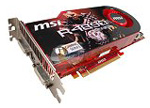 |
If you refer to the recent launch article on the ATI 4890 and NVIDIA GTX 275, you will find these two cards were initially the new choices for the $250 price point. Since then the very popular ATI 4890 has seen tremendous price competition among those selling the card. As a result, an overclocked 4890 can be had for $170 today after $30 rebate. While the GTX 275 performs similarly, it remains around the $250 selling price, with an occasional rebate pushing the price near $200. That is the reason the MSI 4890 OC is the video card choice for both performance midrange systems.
If you prefer NVIDIA cards or NVIDIA drivers, the GTX 275 is an easy substitute in either system. Either card will do the job well and you can shop based on price. The edge goes to the ATI 4890 in the resolutions you will likely run (1920x1200 or lower) with a 27" or smaller display. If you have a 30" monitor, the GTX 275 performs a bit better at those super high resolutions.
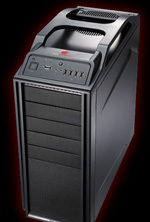 |
The case receives a significant upgrade with the selection of the unique Cooler Master Storm Scout mid-tower case. The Scout has many endearing features, but we would point out the unique rear cutout behind the CPU on the motherboard tray. That makes it possible to install many "through-the-board" aftermarket CPU heatsinks without removing the motherboard. It's a truly clever and useful design element, and we'd like to see more cases support such a feature. The top-mount handle and quiet, effective cooling are also big pluses. Some also want a unique appearance and the Storm Scout delivers with its red LED glow in a distinctive looking case.
Alternates are the Antec Nine Hundred at about the same price and the Antec 902 or Cooler Master Storm Sniper at $160. Both alternatives are very popular with system builders and buyers praise the build quality of both cases.
 |
AnandTech and many other review sites have praised the solid construction, performance, and value of Corsair power supplies. It should come as no surprise that the Corsair 750TX is the choice to power either performance midrange system. The power supply is SLI Ready and CrossFire Ready, 80 PLUS Certified, and Core i7 ready. Power is delivered to a single 60A 12V rail for those looking for that feature and finding it hard to come by at a reasonable price. With a $20 rebate the final cost is $100, which is a great value for a PSU with these specifications, features, and performance reputation.
Most of our editors consider the onboard audio of motherboards to be more than adequate for even gaming these days. That is why we have not chosen a sound card for the performance midrange system. If you want more than onboard surround sound then we recommend the Auzentech X-Fi Forte 7.1 for serious gaming at $140. HTPC users will find much to like in the ASUS Xonar HDAV 1.3 Slim. Other good choices are the ASUS Xonar Essence STX for music, in particular for serious headphone users, or the HT Omega Claro Halo - both run about $200. If you are looking for a good general purpose onboard audio upgrade the HT Omega Striker 7.1 should fit your needs at around $90.
 |
The optical drive for a performance midrange system needs the ability to play Blu-Ray disks. A new model was chosen here with the faster 8X BD read speeds, the LG CH08LS10 Blu-Ray/DVD combo drive. In addition to 8X BD and BD dual-layer playback, you can burn DVDs as fast as 16X single-layer or 12X DL. It cannot, however, burn 25GB/50GB Blu-Ray disks. Adding that capability increases the cost to around $200 to $250. BD burners like the $200 LITE-ON 4X BD-R SATA burner or the $230 LG GGW-H20LK 6X Blu-ray burner are good choices.
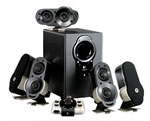 |
Speakers have been upgraded to the Logitech G51 155W RMS 5.1 surround sound speakers. The Logitech rebate has ended, but you can still find the G51 for as little as $120 if you shop, which makes the G51 an excellent value.
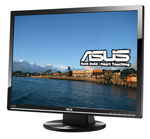 |
The LCD display resolution maintains the 1920 horizontal pixels of 1080p displays but moves to a 26" WUXGA display with a 1200 pixel height. Whatever the minor resolution differences the size of the monitor is increased to a nominal 26" so everything on screen is a little larger (0.292mm pixel pitch). The ASUS VW266H 25.5" HDMI widescreen provides the preferred HDMI input, as well as DVI and an analog VGA port. Panel speed is rated at an incredible 2ms, but we have found most current LCD panels perform similarly and the speed rating does not really guarantee very much. The ASUS monitor provides a large sharp image, good colors, and fast panel speed at a very good price of $300 after rebate. It comes with DVI and VGA cables, but if you plan to connect with HDMI you will need to buy an HDMI cable.
As most readers are aware, LCD panels have been going to cheaper panel technologies and generally declining in image quality. Despite that fact, most buyers are reporting that they are pleased with current LCD screens. It you have a need for exceptional color or yours is a mission-critical graphics task, you may want to look at the HP LP2475w 24" 1920x1200 monitor. This HP monitor is likely the best quality 24" monitor you can buy today, with superior panel technology (S-IPS) and image quality likely to satisfy graphics professionals.
The remaining components are the same as our value systems. The hard drive remains a 1TB WD. The Microsoft OEM keyboard and optical mouse provide input and Vista Home Premium OEM runs the system. For more information on these components you can refer to descriptions on p.3.
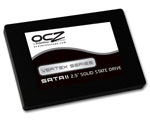 |
In response to those who have asked for SSD recommendations, it is possible to do so based on the months of research and testing performed on SSD drives at AnandTech. For more information on SSD test results please see our SSD Anthology and our SSD update. As we recently reported, you should be on the lookout for further price reductions expected in the next few weeks. The short summary is that the new Intel X25-M G2 SSDs are the top performers, but the price-reduced Indilinx options like the OCZ Vertex and OCZ Agility are viable competitors.










71 Comments
View All Comments
SiliconDoc - Wednesday, August 5, 2009 - link
The idea that the 4870 or the 4890 beats the GTX275 is a FANTASY.-
http://www.driverheaven.net/reviews.php?reviewid=7...">http://www.driverheaven.net/reviews.php?reviewid=7...
http://www.bit-tech.net/hardware/graphics/2009/04/...">http://www.bit-tech.net/hardware/graphi...03/radeo...
http://www.bjorn3d.com/read.php?cID=1539&pageI...">http://www.bjorn3d.com/read.php?cID=1539&pageI...
http://www.dailytech.com/422009+Daily+Hardware+Rev...">http://www.dailytech.com/422009+Daily+H...adeon+HD...
http://www.guru3d.com/article/geforce-gtx-275-revi...">http://www.guru3d.com/article/geforce-gtx-275-revi...
http://www.legitreviews.com/article/944/15/">http://www.legitreviews.com/article/944/15/
http://www.overclockersclub.com/reviews/nvidia_3d_...">http://www.overclockersclub.com/reviews/nvidia_3d_...
http://www.hardwarecanucks.com/forum/hardware-canu...">http://www.hardwarecanucks.com/forum/ha...a-geforc...
http://hothardware.com/Articles/NVIDIA-GeForce-GTX...">http://hothardware.com/Articles/NVIDIA-GeForce-GTX...
http://www.engadget.com/2009/04/02/nvidia-gtx-275-...">http://www.engadget.com/2009/04/02/nvid...275-ati-...
http://www.overclockersclub.com/reviews/nvidia_gtx...">http://www.overclockersclub.com/reviews/nvidia_gtx...
http://www.pcper.com/article.php?aid=684&type=...">http://www.pcper.com/article.php?aid=684&type=...
-
If you're spending $700.00 to $1,600 dollars and a $15 difference on one of your most important components, the videocard, makes your mind up for you... well...
---
NVidia often has 1 or TWO free games with it at the egg - while the red card far less often has just 1. There's another $50 - or $100, going with Nvidia - because of course with either card that makes it a GAMING system - and one would need some games.
---
I wasn't surprised that EVERY CARD in EVERY SYSTEM recommended was the red rooster card - considering where we are.
Mirrorblade - Monday, July 27, 2009 - link
Hiya, for HDD choice you write"While there are differences between hard drives, outside of running benchmarks most people aren't likely to notice the difference in performance between Western Digital, Seagate, Samsung, Hitachi, and other major brands." -
but for memory, you recommend an overclocking memory set, where you could easily save some money (and you don't even give an alternative "for the people that will never want to overclock at all).
.. I don't see any point in advising only overclocking stuff. Sure one might want to overclock, but in this case you could add something as an alternativ, not recommend the OC stuff in general.
Wesley Fink - Monday, July 27, 2009 - link
Even if you never overclock the low-voltage designs of the memory we recommend in the Guide will perform well and last a last time. You can certainly substitute lower cost and lower spec'ed memory if that better meets your needs.Search for a standard like DDR2-800 for the DDR2 systems and DDR3-1066 or 1333 for the Performance mid-range systems. Name brand memory with a real warranty is the better choice - even at the low end. If anything goes wrong quality memory suppliers will replace the bad memory quickly and many better companies offer a lifetime memory warranty.
In comparing memory at the same price choose the one that has the tighter timings, like 5-5-5 instead of 7-7-7. At the same timings and price the one that is specified with the lower voltage is generally the better choice.
nafhan - Monday, July 27, 2009 - link
I think they recommended overclocking memory because they are recommending overclocking in general at this price point. Notice the processor and motherboard choices are geared towards overclocking as well. If you are definitely NOT going to overclock the value midrange, you could buy cheaper memory, motherboard, and (on the AMD side) a non-black edition CPU. You'd save about $100, and still have a fast, reliable system.It might be interesting if they listed a non-overclocking alternative for those parts (Mem, CPU, MB). Although, that may just push things down into the "budget" system range.
IlllI - Monday, July 27, 2009 - link
can anyone tell me if the OCZ ModXStream Pro is better than the ENERMAX PRO82+ http://www.newegg.com/Product/Product.aspx?Item=N8...">http://www.newegg.com/Product/Product.aspx?Item=N8... ? they are both about the same priceThe0ne - Monday, July 27, 2009 - link
I don't know about the enermax but I've researched before purchasing my OCZ 700W PS. Their lower wattage PS have good reviews except for this one but with the recent updates it's gotten better reviews. It was below average before. Sorry I don't have the link to the website that reviews PS.One thing to keep in mind is that if you're not really going to use the max wattage then I wouldn't worry about it. Also, it's best to know your system configuration and try to get a PS with some buffer wattage just in case....you know like when it ages :)
Wesley Fink - Monday, July 27, 2009 - link
Today's price on the OCZ Modular 600W is $50 after a $20 rebate, or an initial cost of $70. The Enermax is a decent PSU, but current cost is $60 after a $50 rebate or an initial cost of $110.The OCZ slightly higher power rating, modular design, and 3-year warranty tilt the value toward the OCZ. Both units are 80 Plus certified, and OCZ has an excellent reputation for Customer Service.
C'DaleRider - Monday, July 27, 2009 - link
That OCZ ModXStream isn't even in the same class as the Enermax Pro82+. Interior construction----the OCZ uses Chinese off-brand capacitors while the Enermax uses high quality name brand Japanese capacitors.Efficiency----not even a contest, the Enermax by a landslide.
Voltage regulation and ripple/noise suppression----again, the Enermax trounces the OCZ.
In all, the OCZ is a mediocre power supply that failed testing when subjected to temps above 40C. On the other hand, the Enermax is better constructed, more efficient, and flew through testing despite being subjected to temps in excess of 40C.
You make the call.
jonup - Monday, July 27, 2009 - link
First the Enermax comes with $50 MIR. Which is a turnoff for many.Second, I just bought OCZ ModXStream Pro 600W (it should ship today) and I did some reading before I bought it. Non of the reviews had an issue with the performance. It performed as rated or better with stable voltages.
Third, for a midrange system it should be running in less then 400-450. At such output the OCZ if working 2 85-86% efficiency. I am not saying that it is better than the Enermax, but in worst case the OCZ will be behind 1-2% which is immaterial.
erple2 - Monday, July 27, 2009 - link
My system (non-overclocked E6750, radeon 4890, 2 memory sticks etc) eats about 325 W at the wall when running at or near full tilt. Factoring in even the highest efficiency available for my PSU (85%), the system is using about 275W of power. I think that the midrange systems listed here (particularly the lower midrange ones) will be chewing through about 300W at full tilt. So I think that the 600W psu should be more than enough.Yes, you can play games with specific efficiencies at specific wattages, but for that you're going to need to see the charts to make that fine-tuned an estimate. But, most power supplies that I've seen reviews for hit max efficiencies between 30 and 60% utilization.
Also, does that extra few percentage of watts make that much of a difference? I dunno. Turn off a light instead. That will save you more power.